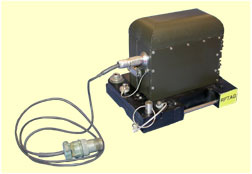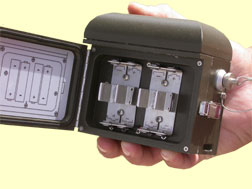NEWS RELEASES
FOR IMMEDIATE RELEASE
October 27, 2005
Sandia demonstrates device for preventing battlefield friendly fire
 Athena Radar-Responsive Tag was demonstrated during
Exercise Urgent Quest in the United Kingdom.
Athena Radar-Responsive Tag was demonstrated during
Exercise Urgent Quest in the United Kingdom.Download 300dpi JPEG image, “athena.jpg,” 644K (Media are welcome to download/publish this image with related news stories.)
ALBUQUERQUE, N.M. — Sandia National Laboratories, along with partners General Atomics Aeronautical Systems, Inc. and Sierra Monolithics Inc., demonstrated the Athena Radar-Responsive Tag during Exercise “Urgent Quest” in the United Kingdom (Salisbury Plains Training Area) Sept. 19 through Oct. 9, 2005.
Athena was developed with sponsorship from the U.S. Army CERDEC I2WD Division and the U.S. Air Force Air Warfare Battlelab.
Urgent Quest is a Military Utility Assessment, associated with the Coalition Combat Identification (CCID) Advanced Concept Technology Demonstration (ACTD), organized to demonstrate the effectiveness of new technologies in preventing friendly fire, or fratricide.
The final report for the exercise will be released in March 2006.
During the demonstration, Athena tags were placed on military vehicles participating in the exercises. The device, tracked via aircraft radar, can be used to identify both U.S. and coalition forces during combat to avoid fratricide. During war, fratricide is the act of killing one’s own soldiers.
 Athena can be used to identify both U.S. and coalition
forces during combat to avoid friendly fire.
Athena can be used to identify both U.S. and coalition
forces during combat to avoid friendly fire.Download 300dpi JPEG image, “athena-open-tag.jpg,” 644K (Media are welcome to download/publish this image with related news stories.)
Aircraft on bombing runs used their on-board radar systems to ensure there were no friendly troops in their sights. If an Athena-tagged vehicle was present, a unique identifier appeared on the pilot’s screen alerting him to a friendly force in his target area, thereby avoiding a potential friendly fire incident.
In preparation for Exercise Urgent Quest, the Athena tag has been demonstrated with several U.S. and European aircraft. In addition to combat identification, the tag can be used for blue force tracking, a similar but not identical mission.
Sandia Project administrator Darick Lewis says the exercises were intended to evaluate the effectiveness of various technologies in preventing friendly fire.
“Ideally, worthy candidate technologies can be transitioned into final development programs and produced for warfighter use,” he says. “Athena is effective because it utilizes a fighter aircraft’s existing radar for detection. It is simple, rugged, small and inexpensive to integrate.”
General Atomics Aeronautical Systems, Inc. (GA-ASI), an affiliate of privately held General Atomics, provides comprehensive solutions for military and commercial applications worldwide. GA-ASI is committed to providing immediately deployable transformational technology for military operations and weapons systems, as well as civil missions. For more information, visit www.uav.com.
Sierra Monolithics Inc. is a leading supplier of high frequency mixed signal ICs and modules for the wireless and telecommunication industries. The company is privately held. For more information, visit www.monolithics.com.
Sandia is a multiprogram laboratory operated by Sandia Corporation, a Lockheed Martin company, for the U.S. Department of Energy’s National Nuclear Security Administration. Sandia has major R&D responsibilities in national security, energy and environmental technologies, and economic competitiveness.
Sandia media contact: Michael Padilla, mjpadil@sandia.gov, (505) 284-5325
For more information see:
www.jfcom.mil/newslink/storyarchive/2004/pa061104.htm
www.act.nato.int/multimedia/articles/2005/090105urgentquest.htm